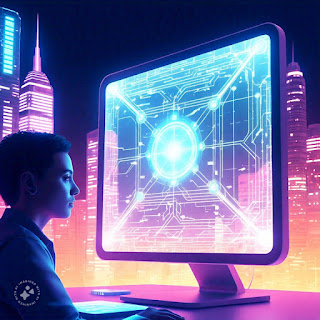Introduction
The internet has undergone monumental shifts since its inception, evolving through various stages—each transforming how we connect, share, and interact. Web3, often referred to as the decentralized web, represents the next frontier in this journey. It’s a paradigm shift that promises to redefine the internet as we know it, putting control back into the hands of users and eliminating reliance on centralized entities.
In this blog, we’ll explore what Web3 is, how it’s evolving the internet, and its potential applications.
The Evolution of the Internet: From Web1 to Web3
-
Web1: The Static Web (1990s - Early 2000s)
- The first iteration of the internet was largely read-only, featuring static web pages. Users could access information but had minimal interaction.
- Examples: Early websites like Yahoo!, AOL, and static blogs.
-
Web2: The Interactive Web (2000s - Present)
- Web2 brought user-generated content and interactivity, giving rise to social media, e-commerce, and dynamic platforms.
- Centralized platforms like Google, Facebook, and Amazon dominate this phase, controlling vast amounts of user data and online activity.
- While it enhanced connectivity and functionality, Web2’s centralization raised concerns about privacy, censorship, and monopoly.
-
Web3: The Decentralized Web (Emerging)
- Web3 aims to decentralize the internet, leveraging blockchain technology, smart contracts, and decentralized networks.
- It focuses on creating a trustless, permissionless ecosystem where users have control over their data, identity, and digital assets.
Key Features of Web3
-
Decentralization:
- Unlike Web2, where data is stored on centralized servers, Web3 relies on blockchain and peer-to-peer networks to distribute information.
-
Ownership and Control:
- Web3 enables users to own their digital assets, from cryptocurrencies to NFTs, and maintain full control over their data.
-
Interoperability:
- With decentralized protocols, Web3 applications (dApps) can seamlessly interact with each other across different blockchains.
-
Trustless Systems:
- Transactions and interactions are verified by blockchain networks, eliminating the need for intermediaries.
-
Enhanced Privacy:
- Web3 prioritizes user anonymity and security through cryptographic techniques and decentralized identifiers (DIDs).
How Web3 is Transforming the Internet
-
Decentralized Finance (DeFi):
- Web3 enables financial systems that operate without traditional banks, offering services like lending, borrowing, and trading directly on blockchain platforms.
-
Data Ownership:
- Instead of corporations monetizing user data, individuals can control and monetize their own data using Web3 tools.
-
New Governance Models:
- Web3 introduces decentralized autonomous organizations (DAOs), where communities can make collective decisions without central authority.
-
Digital Identity:
- Self-sovereign identity systems empower users to manage their online presence and credentials without relying on centralized platforms.
-
Tokenized Economies:
- Web3 facilitates tokenization, allowing creators and businesses to tokenize assets and engage directly with their communities.
Applications of Web3
While we’ll delve deeper into specific applications in future blogs, here’s a brief overview of areas where Web3 is making an impact:
-
Finance:
- DeFi platforms like Uniswap and Aave are transforming traditional financial systems.
-
Gaming:
- Blockchain-based games like Axie Infinity allow players to earn and own in-game assets.
-
Social Media:
- Platforms like Lens Protocol are decentralizing social networking.
-
Supply Chain:
- Web3 improves transparency and traceability in supply chain management.
-
Healthcare:
- Decentralized health records ensure patient privacy and data security.
-
Digital Art and NFTs:
- Non-fungible tokens (NFTs) are revolutionizing art, music, and collectibles.
Challenges in Adopting Web3
Despite its potential, Web3 faces significant hurdles:
-
Scalability:
- Current blockchain networks often struggle with high transaction costs and slow processing times.
-
Usability:
- Web3 tools and dApps can be complex for non-technical users, limiting adoption.
-
Regulation:
- Governments and regulatory bodies are still grappling with how to oversee decentralized systems.
-
Energy Consumption:
- Certain blockchain mechanisms, like proof-of-work, have been criticized for their environmental impact.
-
Security Risks:
- While blockchain is secure, vulnerabilities in smart contracts or user practices can lead to exploitation.
The Future of Web3
Web3 is not just a technological evolution but a philosophical shift toward decentralization, transparency, and user empowerment. As more developers, businesses, and users embrace this vision, Web3 has the potential to reshape industries, from finance and gaming to governance and beyond. However, achieving mass adoption will require overcoming challenges like scalability, regulation, and accessibility.
Web3 represents a future where the internet is more inclusive, equitable, and user-focused—a stark contrast to the centralized structures of Web2. By returning control to individuals and fostering innovation, Web3 is set to become the backbone of the digital economy.
Conclusion
Web3 is more than just a buzzword; it’s a transformative concept poised to redefine the internet’s landscape. With its focus on decentralization, privacy, and user empowerment, Web3 holds the promise of a fairer, more transparent digital future. While challenges remain, the innovations spurred by Web3 are paving the way for an internet that truly belongs to its users.

